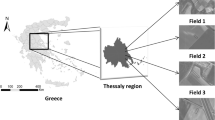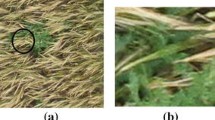Abstract
Many technologies in precision agriculture (PA) require image analysis and image- processing with weed and background differentiations. The detection of weeds on mulched cropland is one important image-processing task for sensor based precision herbicide applications. The article introduces a special vegetation index, the Difference Index with Red Threshold (DIRT), for the weed detection on mulched croplands. Experimental investigations in weed detection on mulched areas point out that the DIRT performs better than the Normalized Difference Vegetation Index (NDVI). The result of the evaluation with four different decision criteria indicate, that the new DIRT gives the highest reliability in weed/background differentiation on mulched areas. While using the same spectral bands (infrared and red) as the NDVI, the new DIRT is more suitable for weed detection than the other vegetation indices and requires only a small amount of additional calculation power. The new vegetation index DIRT was tested on mulched areas during automatic ratings with a special weed camera system. The test results compare the new DIRT and three other decision criteria: the difference between infrared and red intensity (Diff), the soil-adjusted quotient between infrared and red intensity (Quotient) and the NDVI. The decision criteria were compared with the definition of a worse case decision quality parameter Q, suitable for mulched croplands. Although this new index DIRT needs further testing, the index seems to be a good decision criterion for the weed detection on mulched areas and should also be useful for other image processing applications in precision agriculture.
The weed detection hardware and the PC program for the weed image processing were developed with funds from the German Federal Ministry of Education and Research (BMBF).
Similar content being viewed by others
Abbreviations
- DIRT:
-
difference index with red threshold
- LAI:
-
leaf area index
- NDVI:
-
normalized difference vegetation index
- NIR:
-
near infrared
- WDRVI:
-
wide dynamic range vegetation index
References
Aitkenhead, M. J., Dalgetty, I. A., Mullins, C. E., McDonald, A. J. S. and Strachan, N. J. C.: 2003, ‘Weed and crop discrimination using image analysis and artificial intelligence methods’, Comp. Electr. Agric. 39, 157–171.
Baret, F. and Guyot, G.: 1991, ‘Potentials and limits of vegetation indices for LAI and PAR assessment’, Remote Sens. Environ. 35, 161–173.
Biller, R. H. and Schicke R.: 2000, ‘Multi-frequency optical identification of different weeds and crops for herbicide reduction in precision agricukture’, In: Proc. 5th Intern. Conf. on Precision Agriculture, 16.-17.7.2000, University of Minnesota, St. Paul, MN, USA.
Buschmann, C. and Nagel, E.: 1993, ‘In vivo spectroscopy and internal optics of leaves as basis for remote sensing of vegetation’, Int. J. Remote Sensing 14, 711–722.
Chapron, M., Requena-Esteso, M., Boissard, P. and Assemat, L.: 1999, ‘A method for recognizing vegetal species from multispectral images’, Precision Agriculture 1999, 2nd European Conference on Precision Agriculture, Part 1, 239–248. Sheffield Academic Press, UK.
Christensen S. and Heisel, T. 1998: ‘Patchspraying using historical, manual and real-time monitoring of weeds in cereals’, Z. Pflanzenkrankheiten Pflanzenschutz Sonderheft XVI, 257–263.
Christensen, S., Heisel, T. and Paice, M.: 1999, ‘Simulation of long term Alopecurus myosuroides population using three patchspraying strategies’, in: Precision Agriculture 1999, 2nd European Conference on Precision Agriculture, Part 2 (Stafford), pp. 977–987. Academic Press, Sheffield, UK.
Felton, W. L. and McCloy, K. R.: 1992, ‘Spot spraying’, Agric. Eng. 11, 9–12.
Gerhards, R., Sökefeld, M., Nabout, A., Therburg, R. D. and Kühbauch, W.: 2002, ‘Online weed control using digital image analysis’, Z. Pflanzenkrankheiten Pflanzenschutz Sonderheft XVIII, 421–427.
Gitelson, A. A.: 2004, ‘Wide dynamic range vegetation index for remote quantification of biophysical characteristics of vegetation’, J. Plant Physiol. 161, 165–173.
Heisel, T., Christensen, S. and Walter, A. M.: 1997, ‘Validation of weed patch spraying in spring barley –preliminary trial’, in: Precision Agriculture 1997, 1st European Conf. on Precision Agriculture, Vol 2: Technology, IT and Management (ed. Stafford), BIOS Scientific Publishers, Warwick, UK, pp. 879–886.
Hock, B., Fedtke, C. and Schmidt, R. R.: 1995, Herbizide–Entwicklungen, Anwendungen, Wirkungen, Nebenwirkungen, Georg Thieme Verlag, Stuttgart, Germany.
Johnson, G. A., Mortensen, D. A. and Martin, A. R.: 1995, ‘A simulation of herbicide use based on weed spatial distribution’, Weed Res. 35, 197–205.
Kropff, M. J.: 1988, ‘Modelling the effects of weeds on crop production’, Weed Res. 8, 465–471.
Lamb, D. W. and Brown, R. B.: 2001, ‘Remote sensing and mapping of weeds in crops’, J. Agric. Eng. Res. 78, 117–125.
Langner, H. R., Böttger, H., Schmidt, H. and Wartenberg, G.: 2003, ‘Abschlussbericht zum Thema: Messsystem zur Bewertung des Unkrautvorkommens’, BMBF Teilprojekt 02(5444), 09/2001–10/2003.
Laser2000: 2003, ‘Catalogue image processing products’, Comp. Laser2000, Weling (Germany) Bulletin No. 1004, S.49–50.
Lindquist, J. L., Dieleman, J. A., Mortensen, D. A., Johnson, G. A. and Wyse-Pester, D. Y.: 1998, ‘Economic importance of managing spatially heterogeneous weed populations’, Weed Technol. 12, 7–13.
Marchant, J. A., Andersen, H. J. and Onyango, C. M.: 2001, ‘Evaluation of an imaging sensor for detecting vegetation using different waveband combinations’, Comp. Electr. Agric. 32, 101–117.
Oppelt, N. and Mauser, W.: 2004, ‘Hyperspectral remote sensing –A tool for the derivation of plant nitrogen and its spatial variability within maize and wheat canopies’, Precision Agric. 493–498.
Perez, A. J., Lopez, F., Benlloch, J. V. and Christensen, S.: 2000, ‘Colour and shape analysis techniques for weed detection in cereal fields’, Comp. Electr. Agric. 25, 197–212.
Philipp, I., Nordmeyer, H. and Rath, T.: 2003, ‘Algorithms for discrimination of weeds in sugar beet fields using digital image processing’, Proceedings 4. European Conf. on Precision Agriculture, Programme book of ECPA –ECPLF, 527–528, Wageningen Academic Publishers.
Philipp, I., Nordmeyer, H. and Rath T.: 2003, ‘Automatische und manuelle Unkrautkartierung in Zuckerrübenbeständen im Vergleich’, Computerbildanalyse in der Landwirtschaft, Workshop 2003, Bornimer Agrartechnische Berichte, Heft 28, Institut für Agrartechnik Bornim.
Rondeaux G., Steven M. and Baret, F.: 1996, ‘Optimisation of soil-adjusted vegetation indices’, Remote Sensing Environ. 55, 95–107.
Tian, L.: 2002, ‘Development of a sensor-based precision herbicide application system’, Comp. Electr. Agric. 36, 133–149.
Wartenberg, G. and Dammer, K. H.: 2001, ‘Site-specific real time application of herbicides in practice’, in: Grenier, G. und S. Blackmore (eds), 3rd European Conf. on Precision Agriculture, pp. 617–622.
West, J. S., Bravo, C., Oberti, R., Lemaire, D., Moshou, D. and McCartney, H. A.: 2003, ‘The potential of optical canopy measurement for targeted control of field crop diseases’, Annu. Rev. Phytopathol. 41, 593–614.
Author information
Authors and Affiliations
Corresponding author
Rights and permissions
About this article
Cite this article
Langner, HR., Böttger, H. & Schmidt, H. A Special Vegetation Index for the Weed Detection in Sensor Based Precision Agriculture. Environ Monit Assess 117, 505–518 (2006). https://doi.org/10.1007/s10661-006-0768-3
Received:
Accepted:
Issue Date:
DOI: https://doi.org/10.1007/s10661-006-0768-3




